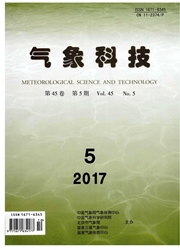

 中文摘要:
中文摘要:
利用常规气象观测资料、区域自动站加密观测资料和GFS 0.5°×0.5°逐6h的分析场数据以及多普勒雷达、风云卫星资料,对2013年6月24日浙江北部一次短时大暴雨天气过程的特征及其成因进行了中尺度分析,结果表明:受西太平洋副热带高压西北部边缘的暖湿西南气流和850hPa暖切的共同影响,引发了浙江北部的短时大暴雨天气。在有利的大尺度环境场和物理量场配合下,当低层925hPa的中尺度辐合线和对流层中层700hPa的垂直上升运动区相重合时,中尺度辐合线附近会产生强对流,这对强对流的发生发展具有一定的预报指示意义。此次暴雨过程与中尺度辐合线密切相关,中尺度辐合线是由偏东风和东北风辐合而成,该辐合线先于降水存在,而且从地面一直伸展到对流层中层,之后触发了浙北地区的短时大暴雨天气,强降水区域和强回波带落在中尺度辐合线附近区域。
 英文摘要:
英文摘要:
The features and formation causes of a conventional observation data, automatic weather resolution of 0.5° and the temporal resolution of 6 short-term heavy rainstorm process is studied by the station data, GFS analysis field data with the special hours, Doppler radar and FY2E satellite data in the northern part of Zhejiang Province on 24 June 2013. The results suggests that due to the influences by the southwest warm moist air flow near the edge of subtropical high and the shear line at 850 hPa, the severe convection was triggered. It has good predictability for severe convection that the 925 hPa mesoscale convergence line overlaid the vertical upward region in the middle troposphere at 700 hPa. That is to say, severe convection could happen near the mesoscale convergence line under the situation. The mesoscale convergence line, which occurred earlier than the rainfall and induced by the confluence of easterly flow and northeasterly flow, triggered the short-term heavy rainstorm in the northern part of Zhejiang Province.
 同期刊论文项目
同期刊论文项目
 同项目期刊论文
同项目期刊论文
 Role of a Meso-γ Vortex in Meiyu Torrential Rainfall over the Bay of the Qiantang River: an Observat
Role of a Meso-γ Vortex in Meiyu Torrential Rainfall over the Bay of the Qiantang River: an Observat Surface Rainfall and Cloud Budgets Associated with Mei-yu Torrential Rainfall over Eastern China dur
Surface Rainfall and Cloud Budgets Associated with Mei-yu Torrential Rainfall over Eastern China dur 期刊信息
期刊信息
